Molly Duffy
Source - https://www.stlbeacon.org/#!/content/26038/cahokia_construction_dig
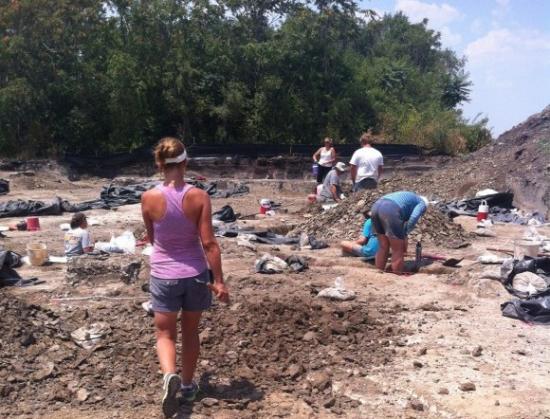
On the last leg of the excavation, the archaeologists working on the Mississippi River bridge project are digging right off St. Clair Avenue in East St. Louis. Molly Duffy | Beacon intern
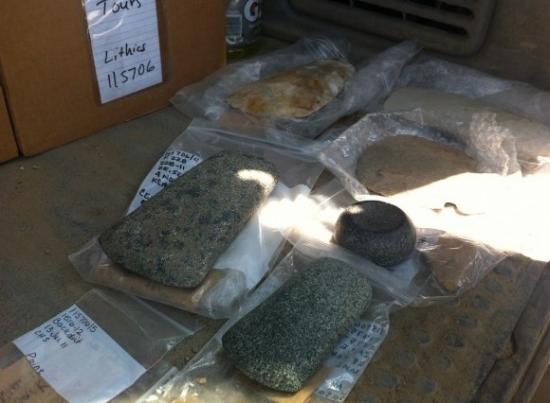
Axes, shovels and discoidal stones that were used for entertainment have been uncovered. Molly Duffy | Beacon intern
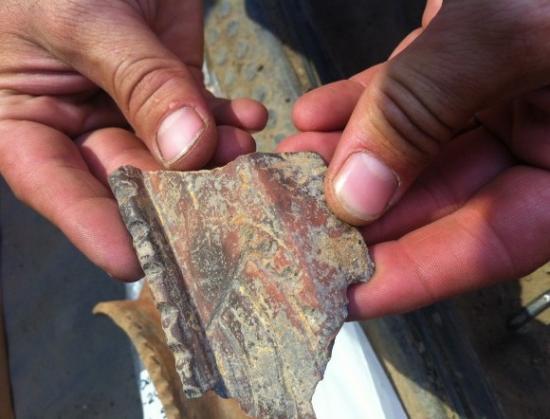
Site Director Patrick Durst holds a piece of an ancient Cahokian bowl, which was likely covered with decorative designs. Molly Duffy | Beacon intern
Driving between Metro East and St. Louis should be easier once the Mississippi River Bridge project is finished, but accessibility to the modern city could lead to the further destruction of an ancient one. The new bridge, which has been under construction since 2008, will reach Illinois in the East St. Louis area, former home to an ancient Mississippian society, part of the vast Cahokian culture. Before breaking ground, the Illinois Department of Transportation sent the Illinois State Archaeological Study to excavate the area. Dr. Joseph Galloy, ISAS American Bottom Survey division coordinator, said they excavated a massive piece of Greater Cahokia, most of which used to be a residential area. Though the MRB project was the cause of the excavation, Galloy said the ripple effects of the project could bring about the loss of other pieces of history. There are very few limitations on what private land owners can do with their land, and with sites adjacent to the new interstate for sale, that could mean destruction of undiscovered Mississippian artifacts and archaeological features. If the land is redeveloped, it won't be the first time Greater Cahokia has been threatened. In the 1800s, almost all of East St. Louis' mounds were destroyed to renovate the area. Without a local push to protect the remaining sites, Galloy said the rest of ancient East St. Louis could be lost as well.
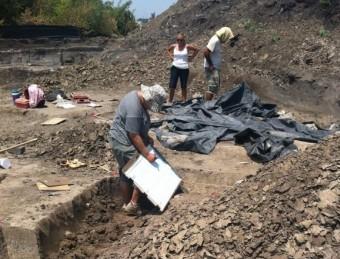
Molly Duffy | Beacon intern - An archaeologist sketches his findings in what the team believes to be an ancient building.
'Big Bang' in ancient times
In 1250 A.D., Cahokia was larger than London, England.. According to Cahokia Mounds' website, the city acted as a base for all Mississippians and reached its peak population between 1050 and 1150. It was a huge mecca for people living in the Midwest and beyond. "Essentially, where there wasn't anything before that resembled a city, the Mississippians came and laid out plans to build a city," Galloy said. It took "tons of time and labor." It still isn't clear how the East St. Louis site was connected to the Cahokia site, or how large the site was. One reason East St. Louis is harder to define is its location in a flood plain. In the 1800s, the city passed an ordinance requiring streets and buildings to be built up on three or four feet of fill, Galloy said, to help prevent flood damage. "What that did was it covered all of East St. Louis," he said. Usually, "when archaeologists go out to look for sites, we can see artifacts on the surface. Well, in East St. Louis, we can't even see the original surface." Without clues on the surface, archaeologists are finding several unexpected features in unexpected areas in East St. Louis.
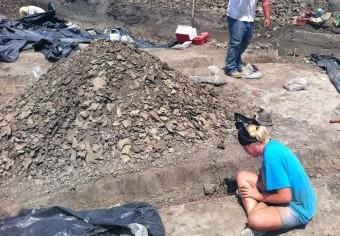
Molly Duffy | Beacon intern- The dug out area may have been an ancient wall.
Today's excavation
A team of archaeologists has been working just ahead of the bulldozers building the new bridge for four years. ISAS Project Archaeologist Patrick Durst said his team has found 5,000 features in the area. Those findings will expand on what is already known about Cahokia, specifically what the Mississippian daily life was like.
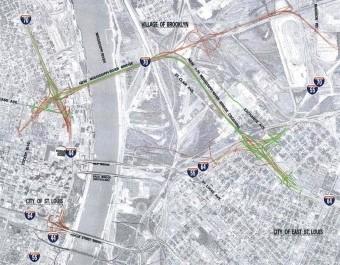
The Mississippi River Bridge Project has a large footprint extending into East St. Louis.
The dig is on about 10 percent of the East St. Louis site, which is believed to cover about 500 acres, Galloy said. "I would imagine the dig we've been doing is the largest in the country for the past four to five years," he said. Archaeologists have uncovered about 1,200 ancient dwellings in East St. Louis. ISAS has also discovered about 70 deep pits, which were used as markers, Galloy said, as well as a mound that was believed to have been destroyed in the 19th century. "That was a bit of a surprise," he said. "And also a pretty significant find." The data set ISAS is building in East St. Louis is unprecedented. With less than a percent of Cahokia excavated, Galloy said the new information will revise what is known about the site, particularly its population. At its peak, Cahokia was home to 10,000 to 20,000 people. Galloy and his team think an additional 3,000 to 5,000 were living in East St. Louis. "It revises upwards our vision, our interpretation, of how big, how many people were coming to this area from outside," he said. Cahokia Mounds Assistant Site Director Bill Iseminger said the dig could also reveal how the Cahokia and East St. Louis sites were related. "There will be perhaps an impact on our understanding of how Cahokia functioned through time and how it related to not only that site (East St. Louis), but also the mounds in St. Louis and other sites in this sort of suburban area," he said.
PART.2